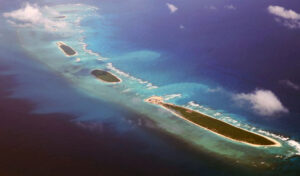Anusha Islam Raha

Settling the question of jurisdiction
Water covers 72% of the Earth’s surface, and due to changing climates and inevitable adverse effects of global warming, this number is only likely to increase. Consequently, it is crucial for every nation to ascertain, for itself and others, the portion of sea over which they have jurisdiction. In other words, it is important to categorize the different portions of the sea into a framework in order to determine the portions over which, and to what extent, a nation has jurisdiction.
To serve this purpose, the United Nations Convention on Law of the Sea (UNCLOS) III 1982 has played a momentous role. This stellar convention, in juxtaposition with previous ones, has corroborated the legal status, breadth, and outer limits of the territorial sea along with the concepts of baselines, internal waters, etc. These concepts are vital elements when determining the aforementioned framework.
To comprehend the starting point from which any water bodies are measured, the concept of baseline comes into play. As per Articles 5 and 7(1) of UNCLOS III, there are two types of baselines, namely normal and straight baselines. “The normal baseline for measuring the breadth of the territorial sea is the low-water line along the coast as marked on large-scale charts.”
However, it is imperative to note that normal baselines can only be adopted if there are no complications along the coast, such as deeply indented coastlines, or islands along the coastline in its immediate vicinity. Following Article 7(1) of UNCLOS III, the straight baseline system is followed in such situations.
After adopting any one kind of baseline that may be altered in the future if required, nations can proceed and label the different types of water bodies.
As per Article 3 of UNCLOS III, the maximum claimable breadth of a territorial sea is 12 nautical miles from the baseline. As for sovereignty, Article 2(1) clarifies that the sovereignty of a coastal state extends to its territorial sea indicating that anything lying within the breadth of the territorial sea will be under the jurisdiction of the adjacent coastal state.
However, even though sovereignty was finally established in UNCLOS III after revising the concepts of territorial sea laid out by Hugo, Woodwell et al, sovereignty still remains in contradiction with the right of innocent passage. This right (necessary for the promotion and protection of international trade, communication, etc) allows ships of all states to pass through the territorial sea which challenges sovereignty and somewhat questions the amount of jurisdiction that a nation has over its territorial sea. Cases such as Corfu Channel (1949) confirms this right by excusing England for “violating” Albania’s sovereignty.
Nevertheless, nations still have the power to exercise their sovereignty and prevent a foreign vessel from entering its territorial sea provided the vessel “is prejudicial to the peace, good order, or security of the coastal state.” Otherwise, coastal states are bound to give the right of innocent passage.
The zone positioned right after the territorial sea is the contiguous zone. This zone may not extend beyond 24nm from the baseline and lies within the framework of jurisdictions because Article 33(1) (a) and (b) clarifies that a nation has the control necessary to prevent and punish “infringement of its customs, fiscal, immigration, or sanitary laws and regulations within its territory or territorial sea.”
The case of Taiyo Maru further held that contiguous zones, including both enforcement and legislative jurisdiction, could be established for purposes other than those detailed in Article 24 of the Territorial Sea Convention.
Adjacent to the contiguous zone is the Exclusive Economic Zone (EEZ) which extends up to 200nm from the baseline. Each coastal state not only has rights over this zone and the natural resources it encompasses, but also has duties towards other states.
Clearly, each zone is under the jurisdiction of a coastal state, indicating a framework that has been underway since the 19th century. However, how ideal is this framework? Does it truly serve its purpose as a framework?
Essentially, a framework’s purpose is to resolve disputes between states, but cases such as Narogne indicate that not only is a country free to enact customary international law to give effect to it, but it also lies within a framework within which disputes regarding same issues keep arising.
Furthermore, the farther from the baseline, the lesser the rights or jurisdiction of the coastal state. Also, sovereignty is in a tug of war with the right of innocent passage for time immemorial, indicating loopholes in the framework which always lead to the question of whether or not a coastal state has the jurisdiction over a particular zone, and if so, then to what extent.
However, this loophole could be seen as an opportunity to design a better framework. Furthermore, since sovereignty will always clash with right of innocent passage, maybe the term sovereignty could be replaced with a term that reflects the current practice of partial sovereignty and defines the Framework of Jurisdictions of Nations over the Sea discernibly.
If current confusions can be cleared and upcoming case laws become precedents for new ones, jurisdictions of nations over the sea will become clearer, clarifying the framework of discussed jurisdiction.
Anusha Islam Raha, LLB (Hons), BPP University, UK, is a Content Writer, International and Comparative Law Journal.




